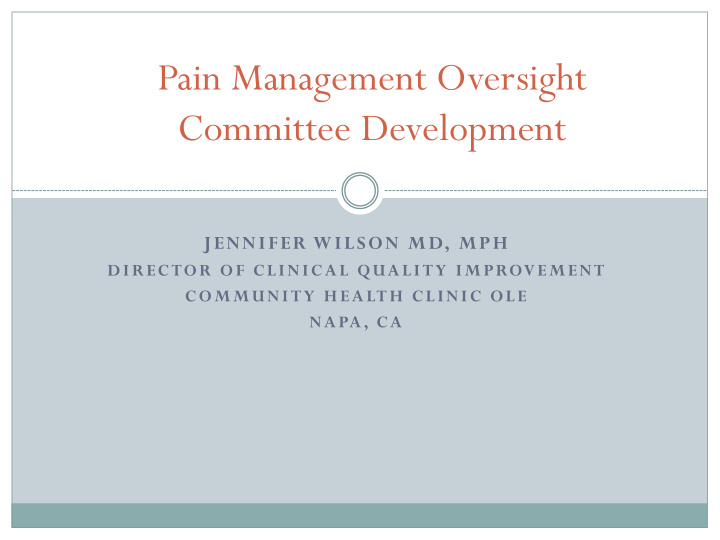



Pain Management Oversight Committee Development JENNIFER WILSON MD, MPH DIRECTOR OF CLINICAL QUALITY IMPROVEMENT COMMUNITY HEALTH CLINIC OLE NAPA, CA
Scope of the problem Managing patients with chronic non-terminal pain is challenging and many clinicians are seeking advice in addressing and managing the complex issues involved Our clinic data validates the challenge as patients with chronic pain have on average 3.7 more visits per year to their PCP These patients are accessing care more than patients with CHF, DM, and COPD
Program Development Participated in Managing Pain Safely Forum facilitated by PHP Got buy-in from providers and leadership team that chronic pain management is challenging and needs additional support to provide safe and effective care Developed clinical practice guidelines for managing pain safely at our organization an documentation standards Planned a retreat with our Care Redesign Team and described the need to make managing pain safely an organizational priority within our strategic plan Developed a work plan to support the strategic goal that “The right patient, receives the right care, from the right person, at the right time”
Work Plan 5 Tactics • Develop specific standardized guidelines for detoxing patients from opiates Birth of the Pain Management Oversight Committee Project Project Aim Statement: • Clinic Ole will provide high quality, safe care to patients with chronic non-terminal pain by reducing the number of patients on >120mg MED, by 50%, by September 30, 2015 Scope: • Currently have 1202 patients receiving opiate prescriptions (735 with dx of chronic pain syndrome) - 3-5% of clinic population
Objectives Our project will support our clinicians in caring for patients with chronic pain by providing evidence- based advice on managing pain safely a multidisciplinary view of the patient’s care suggesting adjunctive therapies encouraging referrals to interventional pain specialists, if appropriate offering recommendations on how to modify medication regimens promoting safe and healthy lifestyles for our patients suffering from chronic non-terminal pain.
Committee Overview Committee is comprised of: Medical Providers Behavioral Health Provider Pharmacist and students Committee reviews patients at highest risk or as requested by PCP: >120mg MED Methadone Opiates and Benzodiazepines concurrently Known or presumed mood disorder/ personality disorder Challenging behavior, non-adherent to treatment plan Committee meets weekly for 1 hour and typically reviews 1 patient each meeting
Communication with PCP Committee provides feedback to PCP via secure email including: Attachment of oversight committee flow sheet Clinical summary of patient’s diagnosis and treatment plan to date Concerns regarding current care plan Recommendations for altering regimen including taper, if necessary
Other Infrastructure Community Health Clinic Ole promotes safe and healthy lifestyles for patients with chronic pain by offering: Chronic Opioid Therapy Orientation Group Co-administered by provider and behavioral health specialist Chronic Pain Management Support Groups Administered by our behavioral health specialist, a registered addiction specialist with special training in chronic pain management Individual Appointments Administered by our behavioral health specialist, for those who may not benefit from group encounters
How will we know we are effective and successful? Outcomes Measure Patients taking >120mg MED will decrease overtime Process Measures Patients being treated for chronic pain syndrome have up to date “Universal Precautions” bundle: Medication Use Agreement CURES report Urine toxicology Balancing measures PHQ9 scores PCP satisfaction with managing patients with chronic pain # visits made to PCP
Barriers Getting data to support our argument and identify patients Stratifying patients was done with a manual calculation Chart review is a slow process
Pain Management Oversight Committee Questions?
Recommend
More recommend